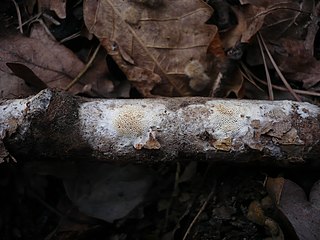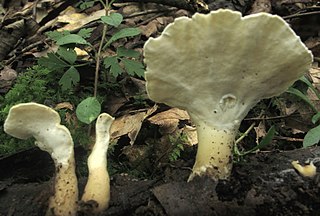Related Research Articles

The Meruliaceae are a family of fungi in the order Polyporales. According to a 2008 estimate, the family contains 47 genera and 420 species. As of April 2018, Index Fungorum accepts 645 species in the family.

The Phanerochaetaceae are a family of mostly crust fungi in the order Polyporales.

Mycoacia is a genus of toothed crust fungi in the family Meruliaceae. It was circumscribed by Dutch mycologist Marinus Anton Donk in 1931.
Columnodontia is a fungal genus in the family Meruliaceae. A monotypic genus, it contains the single species Columnodontia resupinata, a toothed crust fungus found in Borneo. Both the species and genus were described as new to science by Swiss mycologist Walter Jülich in 1979. The main distinguishing characteristic of the genus is the glistening, projecting columns of crystals that make up the spines.

Ceriporiopsis is a genus of fungi in the family Phanerochaetaceae. The genus is widely distributed, and, according to a 2008 estimate, contains about 25 species. Ceriporiopsis was circumscribed in 1963 by Polish mycologist Stanislaw Domanski. The genus is a wastebasket taxon, containing "species that share common macroscopic and microscopic characteristics, but are not necessarily related." Ceriporiopsis species are crust fungi that cause a white rot. They have a monomitic hyphal system, containing only generative hyphae, and these hyphae have clamp connections.

Bjerkandera is a genus of seven species of wood-rotting fungi in the family Meruliaceae.
Bulbillomyces is a fungal genus in the family Meruliaceae. Bulbillomyces is monotypic, containing the single species Bulbillomyces farinosus, a crust fungus. The genus was circumscribed by Swiss mycologist Walter Jülich in 1974. The fungus was reported as new to Japan in 2002.
Cerocorticium is a genus of seven species of crust fungi in the family Meruliaceae.
Conohypha is a genus of two species of fungi in the family Meruliaceae. The genus was circumscribed by Swiss mycologist Walter Jülich in 1975. The crust-like fruit bodies of Conohypha are white to cream in colour and membrane-like. The hyphal system is monomitic, meaning it contains only generative hyphae. These hyphae are hyaline with thin walls, and have clamp connections.

Hydnophlebia is a genus of five species of toothed crust fungi in the family Meruliaceae. All species are wood-decay fungi that cause a white rot.

Loweomyces is a genus of six species of poroid fungi in the family Steccherinaceae.

Radulodon is a genus of toothed crust fungi in the family Meruliaceae. The genus was circumscribed in 1972 by Norwegian mycologist Leif Ryvarden, with R. americanus as the type species.
Uncobasidium is a genus of two species of crust fungi in the family Meruliaceae. The genus was circumscribed by mycologists Kurt Hjorstam and Leif Ryvarden in 1978 with the European fungus U. luteolum as the type species. The South American species U. roseocremeum was added to the genus in 2012. The distinguishing feature of Uncobasidium is the basal hook in the basidium.

Skeletocutis is a genus of about 40 species of poroid fungi in the family Polyporaceae. The genus has a cosmopolitan distribution, although most species are found in the Northern Hemisphere. It causes a white rot in a diverse array of woody substrates, and the fruit bodies grow as a crust on the surface of the decaying wood. Sometimes the edges of the crust are turned outward to form rudimentary bracket-like caps.

Gyrophanopsis is a fungal genus in the family Meruliaceae. Circumscribed by Swiss mycologist Walter Jülich in 1979, the genus contains two species of crust fungi: the type, Gyrophanopsis zealandica, and G. polonensis, added to the genus in 1991.
Obba is a genus of three species of poroid, white rot crust fungi in the family Gelatoporiaceae. The genome sequence of the type species, O. rivulosa, was reported in 2016.
Mycoacia rubiginosa is a species of toothed crust fungus in the family Meruliaceae. It was described as a new species in 2004 by mycologists Kurt Hjortstam and Leif Ryvarden. The type collection was made in Sierra Nevada de Santa Marta, in Magdalena, Colombia, where the fungus was found growing on dead hardwood. It is known only from the type locality. Fruit bodies of M. rubiginosa are distinguished by their reddish colour, and spines up to 3 mm (0.12 in) long. The hyphal system is monomitic, containing only generative hyphae. The spores are ellipsoid, smooth, thin-walled and translucent, with dimensions of 4–4.5 by 2.5–2.75 µm.
Sarcodontia sibirica is a species of toothed crust fungus in the family Meruliaceae. It was originally described by Czech mycologist Albert Pilát in 1936 as Acia sibirica. T.L. Nikolajeva transferred it to the genus Sarcodontia in 1961.
Phlebiporia is a fungal genus in the family Meruliaceae. It was proposed in 2013 by Chinese mycologists to contain the single species Phlebiporia bubalina, a crust fungus. This fungus has a monomitic hyphal system with simple septa, and dextrinoid and thick-walled generative hyphae. There are thin-walled quasi-binding hyphae in the subiculum. Phlebiporia makes spores that are small, smooth, and ellipsoid.

The Irpicaceae are a family of mostly polypores and crust fungi in the order Polyporales.
References
- ↑ Zmitrovich, Ivan V.; Ezhov, Oleg N.; Khimich, Yulia R. (2017). "Niemelaea, a new genus of Meruliaceae (Basidiomycota)". Agriculture and Forestry. 61 (4): 23–31. doi: 10.17707/AgricultForest.61.4.02 .